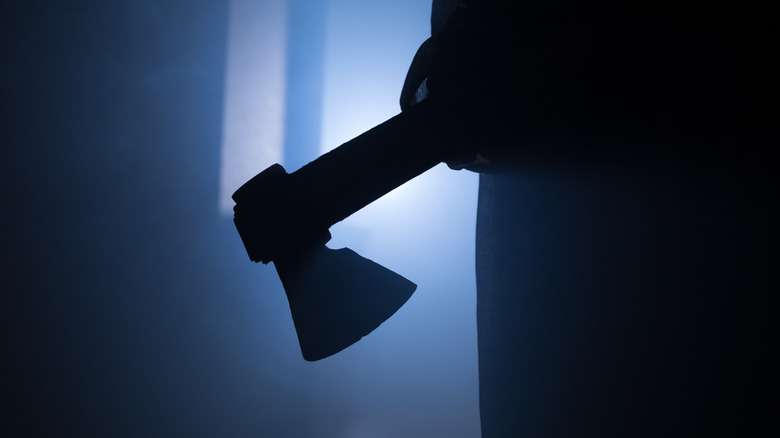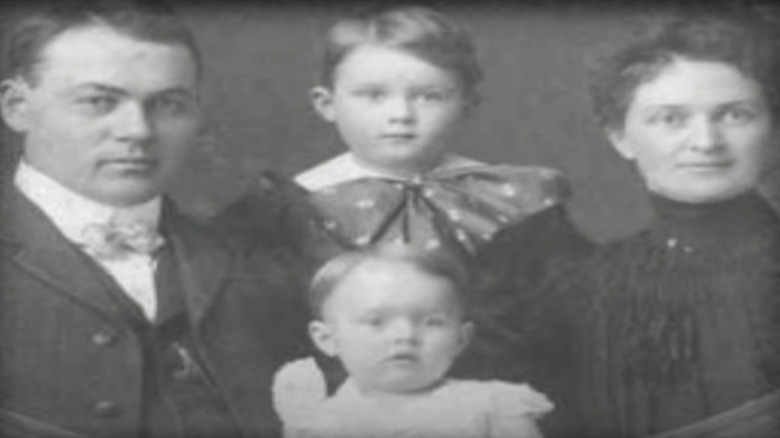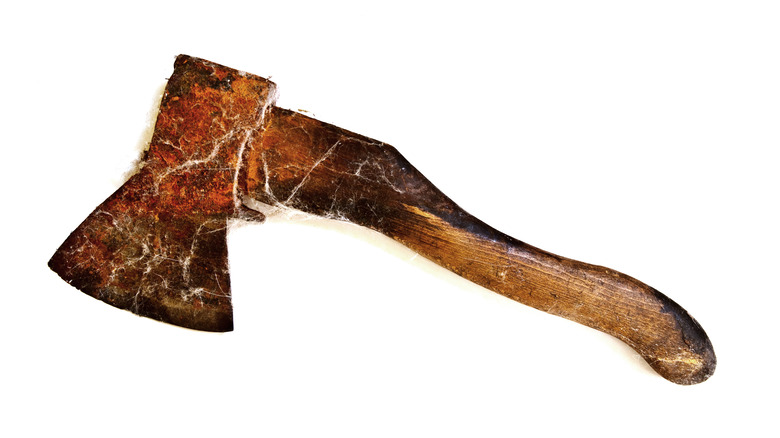The Century Old Ax Murder Mystery That's Still Unsolved
Unsolved murders are an source of intense frustration for investigators and surviving loved ones. Even in the modern world, some murders will forever remain unsolved due to a lack of evidence or no witnesses. As time passes, some murder cases shift from open and active cases and into the cold case files, hoping to one day be reignited by new leads or breakthroughs in technology.
Forensic technology has, of course, brought many killers to justice. Blood, saliva, and other bodily fluids left behind at the crime scene might be too minute to be seen by the naked eye. But in today's world, we have the capability to see what ordinarily cannot be seen, providing valuable clues that are necessary to bring murderers to justice. With that in mind, one might wonder how history would be different if forensic methods would have been available at different points in time.
Perhaps the most notorious murder in Iowa history would have been solved if DNA analysis of evidence had been a technique in the early days of the 20th century. The crime took place in the small farming town of Villisca, in the southwest corner of the state. With eight victims all brutally murdered in their sleep by a crazed ax-man, there was certainly no shortage of carnage. But how could such an act of brutality that took the lives of so many people go unsolved?
The victims
Sunday, June 9, 1912, was a day of celebration in the community. Many of the townspeople had gathered at Villisca's Presbyterian church for the Children's Day service (via Iowa Cold Case Files). This event marked the end of the year for Sunday school, and was commemorated by a short ceremony and a social that was held afterwards. As the day wore on, people began to slowly trickle away from the churchyard. At about 9 p.m., Josiah Moore and his family also left the festivities, going directly to their home on 2nd Street. Along with Josiah and his wife, Sarah, were the couple's four young children: Herman (aged 11), Katherine (aged 10), Boyd (aged 7), and Paul (aged 5). Accompanying the family for an overnight stay were two of the Moore children's friends, sisters Lena and Ina Stillinger, aged 12 and 8, respectively.
Investigators purported that the family went home, had a quick supper, and retired to the bedrooms. The master bedroom upstairs was occupied by Josiah and Sarah, with an adjoining bedroom containing all four of the Moore children. The Stillinger sisters were put to bed soundly in the downstairs parlor. Shortly before midnight, the killer appeared with Josiah's own ax.
Early on the following morning, a neighbor was outdoors, performing her morning chores. She noticed that no one was stirring at the Moore household.
The murders
It struck her as odd; there were four young children and chores to be done, yet no one was out and about (via Unsolved Casebook). Curious, the neighbor approached the door of the Moore house and found it locked. This made for even stranger circumstances, for no one ever locked their doors.
The neighbor grew concerned, and decided to inform Josiah Moore's brother, Ross. Ross Moore appeared with a spare key, and let himself inside. Within a matter of moments, he reemerged, white as a sheet. He told the neighbor he had seen two bloodied bodies lying dead on the parlor floor, and a bloodied sheet on the bed. The now terrified neighbor and brother set off to get the local law, Marshall Hank Horton.
Every bed had a bloodied body in it or next to it. Each occupant had been bludgeoned with an ax, some of them as many as 30 times apiece (via Iowa Cold Cases). The ceilings above the beds in the upstairs bedrooms all had bloodied gouge marks, where the ax had been hefted over and over again by the killer.
The killer, whoever he was, had left several clues after the murders. The mirrors in the home had been covered by pieces of cloth that had been taken from drawers in the bedroom of Josiah and Sarah Moore (pictured above, with two of their children). A slab of bacon was found next to the bloodied ax in the kitchen. A bowl of bloody water was on the table.
The suspects
Investigators believed that the killer had been casing the Moore home for several days (via Unsolved Casebook). After becoming familiar with their routines, the killer was thought to have crept into the Moore home on the afternoon of the murders, hiding themselves in the attic space just off the master bedroom. It was in here that some discarded cigarette butts were found. Neither of the Moores were smokers.
Three initial suspects were named. The first was a state senator named Frank Jones (above). Jones had a rivalry with Josiah Moore, stemming from the two of them operating rival farm implement businesses. Jones had once been the elder Moore's employer, and had become enraged when Moore broke away and began his own business, taking some of Jones's best customers in the meantime. It was quickly ruled out that Jones himself hadn't committed the murders. But had he hired it done?
The second suspect was someone investigators knew had been under suspicion for ax slayings in the state of Illinois several years prior. The lead detective proclaimed that William Mansfield was the culprit, citing suspicions that Mansfield himself had killed his wife and daughter in Illinois, as well as a married couple in Paola, Kansas. While he was arrested two years after the murders in Villisca as a suspect, he was able to prove he was in Illinois at the time of the murders. Though a suspect in the other murders, he was never charged.
Reverend George Kelly, a traveling preacher, was the third suspect.
The trial
In 1917, Reverend Kelly was arrested on suspicion of the murders in Villisca. It was proven that he was in town the day of the murders; he was even at the Children's Day celebration. He also had a reputation for being a peeping Tom, and had been arrested for selling provocative letters to women. Even more curious was that Kelly had taken bloodied clothes to a dry cleaner in a nearby town several days after the murders.
Reverend Kelly was booked for eight counts of murder (via Unsolved Casebook). During further interrogation, Kelly actually confessed. He claimed he killed the Josiah and Sarah Moore first, then the four Moore children, before moving downstairs to kill the Stillinger sisters. He said he was doing the work of "God." He later recanted the confession, saying it was given under duress. At his trial, the result was a hung jury, voting to acquit 11-1 (via Iowa Cold Cases). Prosecutors tried a second time in November of 1917, only to have all 12 jurors vote to clear the reverend of any wrongdoing.
But if Kelly wasn't the killer, who was it? The prevailing theory is that the Moore's were victims of a serial killer who traveled by rail. The hired detective who tried to pin the Moore murders on William Mansfield had tried to unsuccessfully tie him to ax murders in Illinois and Kansas. But those three weren't the only murders.
The ax murder house today
A family in Colorado Springs was murdered in the same manner, as were families in Ellsworth, Kansas; Mount Pleasant, Iowa; and Rainier, Washington. These murders all took place near railroad lines within a period of several years. In four of the cases, the killer had covered the mirrors with cloth before leaving, and at one scene, had left a bloody bowl of water.
Over a century has passed since the family of Josiah Moore and the Stillinger sisters were mysteriously murdered by an unknown assailant. The case has continued to spark both curiosity and controversy in the years that have passed. The Villisca Ax Murder Case has been the subject of several documentaries, and has even had a low budget horror movie based on the house.
Since the mid 2000s, visitors from all over the world have come to Villisca, Iowa to tour the Moore house. The current owners have it restored to the way it was during the murders, complete with gas lighting and period furniture and decorations. According to their website, for an additional fee, you can reserve a night's stay in the house. If you're brave enough. Local lore claims that the house has been haunted for years by the victims of the murders that terrible night in 1912.





